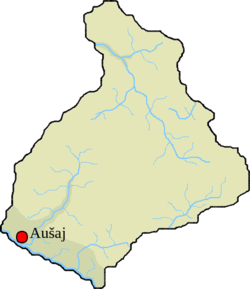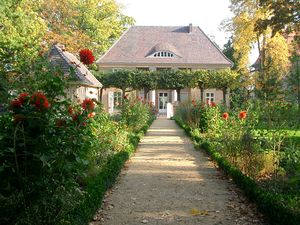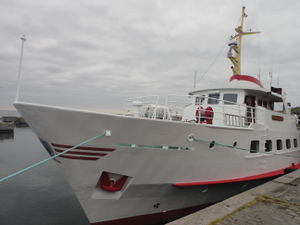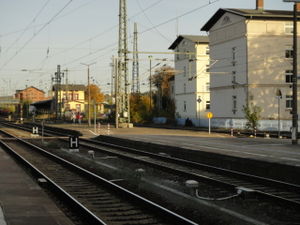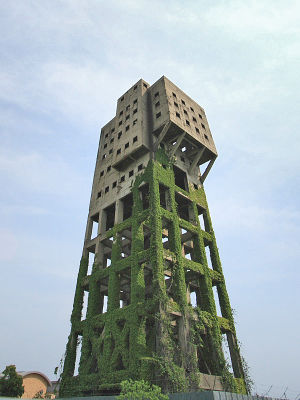Difference between revisions of "Lufasa"
m (→Economoy) |
|||
| Line 180: | Line 180: | ||
Despite being a landlocked country, Lufasan forces also include a navy in addition to ground forces and an air force. It is stationed on two bases at the river Ersaj, near borders.==Economy== | Despite being a landlocked country, Lufasan forces also include a navy in addition to ground forces and an air force. It is stationed on two bases at the river Ersaj, near borders.==Economy== | ||
== | ==Economy== | ||
[[File:DSC01461.JPG|thumbnail|right|Ships on the Ersaj River are used for trade and fishing]] | [[File:DSC01461.JPG|thumbnail|right|Ships on the Ersaj River are used for trade and fishing]] | ||
Lufasa has a modern industrialized economy, however industrialization reached Lufasa only late, in the 1930s when the manufacturing sector began to become big enough to start using mechanization, automatization and motorization and on the other side demand for consumer goods was on the rise. But the change was all the more swift, and with the help of foreign capital, both regional and overseas, many new factories, mines, and other gigantic structures appeared almost overnight across the country for the explosively growing manufacturing sector. The northwest of the capital and alongside several nearby tributary rivers were particularly popular locations due to good transport connections via water and the possibility to install hydro-electric power plant. | Lufasa has a modern industrialized economy, however industrialization reached Lufasa only late, in the 1930s when the manufacturing sector began to become big enough to start using mechanization, automatization and motorization and on the other side demand for consumer goods was on the rise. But the change was all the more swift, and with the help of foreign capital, both regional and overseas, many new factories, mines, and other gigantic structures appeared almost overnight across the country for the explosively growing manufacturing sector. The northwest of the capital and alongside several nearby tributary rivers were particularly popular locations due to good transport connections via water and the possibility to install hydro-electric power plant. | ||
Revision as of 10:25, 14 July 2021
| Republic of Lufasa Lufòasa |
||||
|---|---|---|---|---|
|
||||
| Capital | Aušaj | |||
| Official languages | Ohnaucan | |||
| Recognised national languages | Gfiewish | |||
| Demonym | Lufasan | |||
| Establishment | ||||
| - | Independent from Gfiewistan | 1852 | ||
| Area | ||||
| - | Total | 47,510 km2 18,344 sq mi |
||
Lufasa (Ohnaucan: Lufòasa [lufɔasa]), officially the Republic of Lufasa, is a landlocked country located in Northern Ystel, neighboring Mermelia in the west and northwest, Kranxram in the northeast and east, Saant in the southeast and Gfiewistan in the southwest.
Similar to South Jute, it was originally settled by refugees from Jute speaking Middle Jutean, but due to losing contact to the homeland relatively quickly and the proximity to Gfiewistan and the influential Gfiewish chiefdom of Hatariew in particular, it soon came under Gfiewish influence and later also until 1852 Gfiewish rule, which has left marks in both its language (in the form of numerous loanwords) and its culture, which is markedly less traditionalist and more open to commerce and technology than the one of Jute, not to mention industry. In general, it features a mixture of the dominant collectivism typical for Jutic cultures and the individualism prominent in Gfiewish culture. Its culture has additionally inherited various other characteristics from the two.
Like Gfiewistan, from which it took its current-day political institutions after far-reaching reforms in the 19th century, it is a non-partisan representative democracy with a unicameral legislative; however, much decision- and lawmaking is devolved to local community assemblies and the president is mostly limited to ceremonial functions owing to the cultural heritage of Jute and its tradition of village democracy.
Its main economic sectors are agriculture, which above all produces fruits and vegetables for Gfiewistan that are unable to grow there, and the commerce sector, with the country functioning as an important gateway for trade between the neighbor in the south and East Mermelia in the north as well as northern Ystel in general. As member country of the Ystelian Community, and as a result the Ystelian Market Common Area (YMCA) and the Asuran Economic International Oceanic Union (AEIOU) it enjoys free trade with more than twenty countries in Ystel, Baredina, Lahan, Nagu, Asuranesia and Parshita.
Etymology
From Middle Jutean 'lupoeata, derived from lupoe (creek) and an unknown suffix.
History
Prehistory
Before the second century AD, the land of modern-day Lufasa was sparsely populated by various nomadic tribes and few Maponic communities belonging to chiefdoms. Their chiefs occasionally tried to extend themselves to cover the entire territory, but usually had to gave up quickly due to the land being difficult to defend, with it consisting mostly of plains with few natural defenses aside from a couple rivers. At the beginning of the second century, fleeing Juteans land on Ystel and establish settlements at the lower part of the Hatariew river. While most remained close to its mouth, founding the town of Laina and later several small villages in varying distances from it, some traveled further east alongside the river, and by 150 AD had reached the site of modern-day Aušaj.
Growth and beginning of Gfiewish influence
Settlements and hamlets founded in this region saw a big increase in population around 475 AD, when Laina and its surrounding lands suffered an epidemy and most of the town was destroyed in a huge fire, leading many to flee east and southeast. A generation later, in the first half of the sixth century, they had formed a first larger settlement resembling a protohistoric urban center that later came to be known as Xanapeshua, Middle Jutean for 'Place of benevolent spirits'. As chiefdoms start to emerge, so does the influence of the now more developed neighboring chiefdoms, and by 700 AD Xanapeshua and its vicinity had become a tributary to the chiefdom of Hatariew on the other side of the river. This is evidenced by the appearance of weapons and other artifacts that are typical for the early Gfiewish principality that are unlikely to have arrived there as a result of trading.
Five hundred years later, in 1210 AD, modern-day Lufasa is subsumed entirely by Hatariew and as a result, Gfiewish cultural and political influence only continues to increase. Northern Gfiewish architectural styles appear in Xanapeshua, food and clothing undergo gradual changes. Its Jute-style assemblies are now reduced to mere advisory bodies and are mentioned 1436 for the first time in writing. Xanapeshua remains the biggest town in the region, however by 1574 it is mentioned in records as "Aušaj", as the large amount of Gfiewish settlers and the Gfiewish or Gfiewized nobility came to call it by the river it is located at, with local recordkeepers ohnaucanizing the Gfiewish name "Ersaj" to "Aušaj". Immigrants to the town tend to quickly assimilate to the dominant Gfiewish culture, and so native culture survives mostly only in the countryside. However, even there Saandism begins to give way to the pre-Iovist religion of Gfiewistan.
Incorporation into the Kingdom of Gfiewistan
After the Great Unification War of Gfiewgjknsiorjgiostan began in 1567, Lufasa becomes a stronghold of resistance to the unification efforts of the chiefdom of Slakkariew and was together with Kebbzol one of the last holdouts to be defeated. Iovism is introduced, but the conversion is only completed at the beginning of the 18th century, and even then syncretic faiths combining Iovist and native elements continue to exist in defiance of missionary efforts. As a result, local culture, such as the celebration of Jutic holidays and festivals, the public singing of folk songs or any other public display of Lufasan traditions, is quietly suppressed. Schools enforce the teaching of the Gfiewish language, Gfiewish customs and declarations of loyalty to the royal court.
At the end of the 18th century, when media control was started to be relaxed under the pressure of university students and researchers in Hatariew and later also local nobles. While this had not much of an effect in other chiefdoms, where censorship was often merely replaced by self-censorship, Lufasa’s capital Aušaj is only a short distance and a river crossing away from the city of Hatariew and so had always been very influenced by it, politically, economically, and culturally. As a result, the reach of the royal court in Slakkariew was mostly very limited and Lufasan media similarly began to liberalize and become more critical and diverse.
Rise of nationalism and independence
Many of the same factors that drove support for republicanism in the country overall also were existent in Lufasa, such as social and political problems, widespread corruption, and a governing system increasingly perceived as oppressive and out of touch with the needs and values of the people. Over the course of the first half of the 19th century this ultimately led local writers and reporters to not just to challenge government policy, but also the very existence of the royal court, as in Hatariew first secretly, as criticism of the court itself was still outlawed, but as resentment and the republican movement grew, also more and more openly.
While anti-clerical sentiment was less common as Iovist missionaries never managed to fully convert the land and instead syncretic faiths had prevailed, the liberalization of media was crucial for another reason, as it allowed for a rebirth of local cultures in Lufasa, as it became possible to easily share new and old folklore, songs, poems and more. For the first time in centuries local patriotism could be also openly expressed having previously been quietly suppressed under suspicions of insufficient loyalty to the court in Slakkariew.
Eventually, what had begun with printings of simple folk songs and texts on the simple appreciation of the natural landscape and farming traditions led to a growingly confident belief in the value and importance of a distinct Lufasan culture and finally culminated in assertions of the existence and need of a separate identity. Like republicanism, this Lufasan nationalism only was able to gather widespread support and consequently succeed in its goal thanks to the hard-won media freedom that invigorated the printing business and made it possible to share ideas and creative works supporting them quicker than ever before.
The land remained an integral part of the Kingdom of Gfiewistan until 1852, when following the Republican Revolution the nobility is abolished and nationalistic tendencies culminate in Lufasa splitting off and becoming independent again. The following year the assemblies across the country regain most of their power, however the system now takes strongly from modern Gfiewish political institutions, including establishing the office of a president, although only with representative functions. Diplomatic relations are quickly established with other countries in Ystel, but ties to Gfiewistan remain the strongest, and it is mostly Gfiewish investment that brings industrialization to the country in the 1930s, though local richer farmers also contribute to a sizable amount of investment and economical development. It is also Gfiewistan that the country signed its first defense and free trade pact with in 1948, following almost a century of often heated debates in the upper bicameral assembly and very long negotiations. In 1976 Lufasa is one of the founding members of the Ystelian Community, abolishing tariffs to other Ystelian countries as well, and eventually forming part of the YMCA (Ystelian Market Common Area). Due to its central location it has become an important trading hub in northern Ystel.
Geography
Geology
Climate
Biodiversity
Politics
Overview
When Lufasa got its independence from Gfiewistan in 1852, it inherited most of the political institutions of the federation, however, owing to its prior status as a federal subject and its Jutic heritage of local collective decision-making (village democracy) there are also major differences to modern-day Gfiewistan.
Unlike Gfiewistan, Lufasa is a unitary state, which is a result of it being effectively a federal state that achieved full independence. Nonetheless, power is not entirely centralized, but typically devolved to local community assemblies that can be attended by any citizen, owing to the Jutic cultural heritage of village democracy. Additionally, while the office of the head of state exists, similar to republican Gfiewistan and Jute it is a more ceremonial office with little power.
Political culture
Another difference is that parties are not formally banned in Lufasa the way they are on the other side of the Ersaj, however, they have remained largely unpopular due to the importance of village- and neighborhood-level politics. Local issues and personal relations are therefore more salient than organization along ideological lines for political collaboration and voting on decisions or for representatives for the higher levels of administration (regional and national). The ability of local community assemblies to largely set their own laws where a law on the national level does not exist or allows for a certain amount of leeway. This contrast with South Jute, another culturally Jutic country, where the local assemblies do not have any legislative powers.
Administrative divisions
Foreign relations
Gfiewistan is the most important ally and trading partner of Lufasa, and since the 1948 Pact of Aušaj, Gfiewistan is contractually obliged to aid the country in times of war and raise no tariffs on Lufasan goods coming in. Lufasa is also part of the Ystelian Community, Ystel's international economic organization and hence also the YMCA (Ystelian Market Common Area), which is linked with the AEIOU (Asuran Economic International Oceanic Union).
Military
Despite being a landlocked country, Lufasan forces also include a navy in addition to ground forces and an air force. It is stationed on two bases at the river Ersaj, near borders.==Economy==
Economy
Lufasa has a modern industrialized economy, however industrialization reached Lufasa only late, in the 1930s when the manufacturing sector began to become big enough to start using mechanization, automatization and motorization and on the other side demand for consumer goods was on the rise. But the change was all the more swift, and with the help of foreign capital, both regional and overseas, many new factories, mines, and other gigantic structures appeared almost overnight across the country for the explosively growing manufacturing sector. The northwest of the capital and alongside several nearby tributary rivers were particularly popular locations due to good transport connections via water and the possibility to install hydro-electric power plant.
Many locals tried to profit from the building boom and and a lot of construction companies were founded. However, while a few companies managed to attain sustainable growth, the boom was overall short-lived, as many of the new foreign-funded enterprises and projects failed to be profitable due to various reasons, or ran out of money half-way through construction.
As a result, the most important exports remained agricultural goods, especially grains and pseudo-grains such as buckwheat, oats and corn. When Lufasa was under Gfiewish control, it served as the breadbasket for the kingdom, as well as delivering many of the fruits and vegetables that can’t be grown in Gfiewistan in significant amounts (if at all), and while the production is now under local control, agriculture remains the biggest sector and the neighbor in the south across the river remains the most important trading partner.
Additionally, with its central location in northern Ystel also Lufasa has also since medieval times served as a hub for trade into other countries in northern Ystel, such as Mermelia, South Jute or Kranxram, as many trade routes pass through the land. Commerce, shipping and supporting sectors have thus grown to become the second biggest sector. With the political and economical center located at the large river Ersaj, ships and boats have for most of history been the main way of transporting goods in and out of the country, although in the 20th century they have been increasingly superseded first by railways and later trucks and brucks.
Tourism
Transport
Roads connect most cities and towns, and ferry transport exists on the river Ersaj, providing an alternate connection to the Gfiewish capital, Hatariew and Lakwa, the capital of the Gfiewish state Kebbzol.
Railroads mostly restricted to a single loop connecting the major settlements in the south and international connections to the neighboring states of Gfiewistan, Mermelia and Shelhania. Similar to Gfiewistan, Lufasa’s railway network was much more expansive in the past. As all towns and larger villages in the country had a state-subsidized post office, “mail rail” supplying them ran on tracks covering almost every corner of the country. Sometimes these were minor narrow-gauge branch railways with infrequent or irregular use, but most offered passenger service several times daily.
Before the advent of automated sorting, mail was sorted on the train to save time in a dedicated railway car. Passengers were also allowed to give post workers additional mail to deliver, or could get stamps onboard. Economically, mail rail provided employment for many underdeveloped regions. However, with the widespread adoption of cars and the construction of highways as well as the use of sorting machines, it became uneconomical to use and almost all railway lines were given up, with only the lines servicing large towns in the southern part of the country and international connection to neighboring towns remaining. Other ones were replaced by bus lines or in some cases given up entirely.
Most of the tracks are still in existence and used by recreational vehicles, and many old railway stations have become small museums, but there is also an ongoing effort by interest groups to revive many of them and make travel in Lufasa less dependent on the car, as the buses in use now provide less comfort, are generally less reliable and take more time, especially when stuck in traffic.
Energy
Science and technology
Demographics
Ethnic groups
Urbanisation
Language
Education
Healthcare
Religion
Attempts to convert Lufasa to Iovism by the Gfiewish king when it formed part of the kingdom of Gfiewgjknsiorjgiostan were unsuccessful for the longest time, with Lufasa being the last state of the kingdom to adapt Iovism in the early 18th century. Even after that, the regional traditional religion remained important, having in most of Lufasa outside of the capital formed a syncretic faith combining aspects of Iovism and the native pre-Iovist religion, and generally remaining culturally important.
Culture
Lufasan culture originated as a Jutic culture, being the southernmost in the world. However, a very long history of contact and exchange with local Ystelian cultures has had major influences, among them particularly the Gfiewish ones, which dominated the Lufasa for centuries, culminating in efforts to suppress local culture in the 18th century. Efforts to revive Jutic and uniquely Lufasan heritage began in the 19th century and and reached their peak in the second half of the 19th century after independence.
Cultural heritage
Central to Lufasan culture is a deep appreciation of rivers. They run through most of Lufasa, and are important to local mythology and the spiritual beliefs of much of the population, that sees rivers as the natural, nourishing mothers of the country, as they provide, among other things, easier irrigation for fields and an easy means of transport between the villages and towns of the country. Literature, novels and poems, often centers around them. Additionally, they are a popular place for recreational activities such as fishing, swimming, boat trips and social events often take place at river shores. In many villages and town districts these happen weekly or at least monthly during the warmer months. In winter, ice fishing, ice skating and winter markets are popular in some regions.
As a result of the Jutic heritage and the Gfiewish influence, Lufasan culture is generally more community-based than the typically strongly individualist Gfiewish cultures, but notably less communitarian than other Jutic cultures in South Jute or especially Jute. The impact of both cultural groups can also be seen in many other fields and local beliefs, such as the idealization of farm work shared with Gfiewistan, and the tradition of environmentalism Lufasa has in common with Jutic cultures.
Environmentalism
Environmentalism has a long tradition in Lufasa, with its roots going back to the time before the emergence of Lufasans as a distinct culture and ethnicity. It is commonly seen as inheritance from the Jutic culture that Lufasan culture descends from, an aspect of the ancient Jutic religion of Saandism that became a part of the profane culture and so survived the conversions to first the ancient native religion of the Gfiewish chiefdoms as well as the later attempts by the Slakkariew-led Gfiewish kingdom to introduce a new, scriptural religion. However, as both of these religions, especially the former one, can have environmentalist streaks, this is not uncontested.
What is not contested is that according to oral tradition already in medieval times preservation of forests and rivers wasn’t just religiously driven, but also seen as culturally important and often even just prosaically as necessary for economic reasons, as the basis of human life in the material world. Whether one motivation lead to the other or whether all appeared independently is impossible to say for sure.
Concern for the preservation of the soil and surface of fields and their natural biodiversity might also have originally derived from religious beliefs, either the desire for a harmonious relationship with nature of Saandism or the belief in the need to care for the environment as if it were one’s own body of the local Ystelian religion. But in either case it seems to have lost its sacred component fast, with no records, traditions or stories indicating a religious or spiritual connection. The general assumption is hence that care was applied to not exhaust the soil and avoid monocultures mostly to ensure good harvests in the following years, an early example of sustainable economic behavior.
An alternate theory is that this behavior arose from, or was at least reinforced by encounters with Gfiewish officials or farmers less concerned about soil health and the protection of local ecosystems demanding or using farming methods that caused recurrent harvest problems. In either case, it later became the subject of folk songs and poems, but only once the traditions had been firmly established and became a marker of identity.
This allowed environmentalism to develop a new dynamic, as it came to be seen increasingly as one of the crucial differences that set Gfiewish people and Lufasans apart after centuries of Gfiewish cultural dominance that had led to an increasing amount of assimilation, and as such became a key theme in many nationalist works and a motivation for seeking independence.
Rivers are among the most important concern of conservationists and environmentalists, as the past and present industrial activity, especially in and near the capital region, often caused severe pollution in several spots and clean-up activities are regularly organized by local activists and governments.
Mythology and occultism
Lufasan mythology is a mixture of traditional Jutic beliefs, local pre-Iovist mythology and other more recent influences. Aside from rivers being regarded as the spiritual mothers of the country, other natural objects such as hills, forests and boulders feature prominently in stories, legends and predominating cultural worldviews. Until independence in 1852 these were mostly limited to oral tradition, but after that books on the subject became very popular and book stores specializing in them started to appear.
Later, these stores often widened their selection to include any and all writing and objects associated with mythology, the supernatural and paranormal, with those that shifted their focus entirely towards the latter two becoming known as "dark stores". Much of these center around certain locations of human activity rather than natural features as with mainstream Lufasan mythology. A number of abandoned factories, mines etc. are commonly claimed to have been the site of encounters and experiments involving supernatural forces, that resulted in the creation of devices and materials that can grant superhuman strength or any number of other special abilities. Maps purporting to lead to those sites are nowadays also available on the internet, with the distinctions between genuine belief, scam and parody being blurred.
Cuisine
Lufasa's cuisine mostly consists of dishes made after traditional Jutean recipes adapted to local and typically Gfiewish ingredients as well as Gfiewish dishes, made in cookware originally from Jute or introduced by Gfiewish people. Among the former are e.g. large pans on top of a fire (open on Jute, but typically enclosed with bricks on three sides in Lufasa) and among the latter small, but deep pots used for boiling and cooking on fire, as well as oven dishes in various shapes and sizes.
One of the oldest and most well known staples is a buckwheat pancake, fried in a pan similar to Jutean coconut or banana flour pancakes, although with the introduction of corn filled corn flour pancakes became another common dish later on.
Sport
With rivers being central to life in Lufasa, water sports suitable for rivers, such as swimming, fishing, canoeing and boat racing have historically been the most popular and continue to be so in the present day.
This also extends to the winter months, when ice fishing and ice skating are common. In addition to that, the influence of Gfiewistan has led to soccer clubs developing across the country, with a small league organizing tournaments every year. There are also regular friendly matches with Gfiewish clubs.
Media
After gaining independence in 1852 as a separate republic, censorship was formally abolished and many new newspapers were founded. Regulation of media became responsibility of the newly elected national assembly, which then decided to fund a public press to publish educational material to fully break the dominance of the temples in regards to education, and to subsidize the existence of libraries and post offices with newsstands across the country. For a lot of local newspapers, this remains an important way to reach their audience and has prevented consolidation on the print media market. It also helped them fend off competition from first national newspapers and later TV and internet newsportals.
Radio was introduced in the 1940s. Among the first stations was also a public one founded by the assembly, first for educational purposes and to transmit assembly meetings, after a period of public skepticism also for traditional, and later, modern music.
Unlike in Gfiewistan, private and community radio stations were allowed to operate from the beginning on, leading Lufasa to develop a large radio culture and so still have a bigger variety of radio programming than Gfiewistan despite its much smaller size. Both AM and FM stations continue to be widely popular and many more smaller local stations, usually founded by local newspapers or volunteers, are available than in the large neighboring country. They tend to have a hyperlocal focus on news, events, discussions and more relevant to particular communities.
On the other side, there are only few TV stations, as public acceptance of this medium was slow and initial interest not very high. One of the biggest drawbacks generally cited was the lack of portability, making it no alternative for people working on farms, commerce or in jobs requiring longer commutes. This only began to change as TV devices started getting cheaper and new, more varied programming started drawing viewers. Nonetheless, it remains more of a niche medium than a truly mainstream one.

